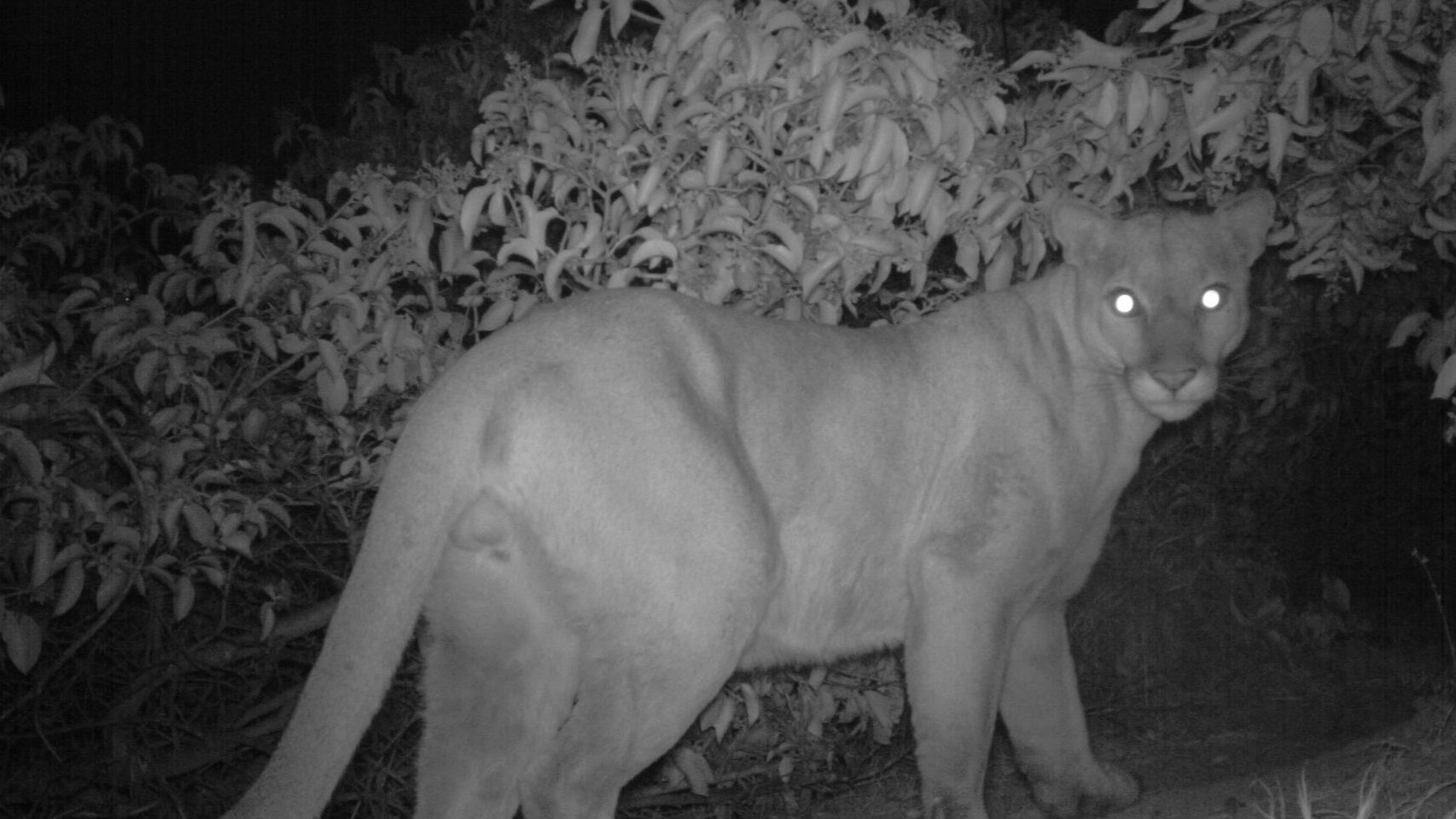News Release

National Park Service
|
Subscribe
|
Contact: Ana Beatriz Cholo, 805-750-9356 (cell); 805-370-2385 (office)
THOUSAND OAKS, Calif. -- Dramatic new surveillance video shows mountain lion P-61 getting chased by a male uncollared lion minutes before he was struck by traffic and killed on the 405 Freeway early on the morning of September 7, National Park Service biologists say.
The first grainy black and white video clip, with a timestamp of 3:09 a.m., shows P-61 being chased by another mountain lion and climbing into a tree. More than two minutes go by before the other lion climbs up the same tree P-61 is in. The second video clip is 26 minutes later with a timestamp of 3:35 a.m. It shows a lion dropping down from the tree and running off with the second animal following closely behind.
The third and shortest video, with a timestamp of 3:35 a.m., shows who we believe is P-61 as a blur crossing a road. He heads south and is adjacent to the 405 Freeway. The fourth and last video, with a timestamp of 3:36 a.m., shows an uncollared mountain lion briskly walking under the 405 Freeway. He heads in the direction of Sepulveda Boulevard where a construction crew is working under bright construction lights. He abruptly turns around before heading south and alongside the freeway in the same direction as P-61.
Minutes later, at around 4 a.m., P-61 was struck and killed on the 10-lane freeway. He had managed to run across at least five lanes of traffic, but ended up dead on the southbound lanes.
“There’s no bad guy in this scenario,” said Jeff Sikich, a biologist with Santa Monica Mountains National Recreation Area (SMMNRA), referring to the uncollared adult male mountain lion likely protecting his home range, which appears to be to the east of the 405 Freeway. Over the last four years, Sikich said, an untagged male mountain lion has been captured on remote cameras in the patchwork of habitat between the 405 and 101 Freeways, which is assumed to be the lion that chased P-61.
“This is what male mountain lions instinctively do and it did not end up in P-61’s favor,” Sikich continued. “The difference is that this is real life mountain lion behavior playing out in an urban and fragmented landscape that is complicated by busy roads and development.”
The fact that researchers were able to document this kind of interaction between animals is extremely fortuitous and provides a fascinating insight into their behavior. It is rare to catch even a glimpse of these secretive and often nocturnal animals, let alone see a significant event like this.
P-61 is the 19th mountain lion to die from road mortality over the course of our 17- year study and the 8th collared animal. Vehicles and intraspecific strife, a term used to describe conflict between animals of the same species, are the top two causes of death for mountain lions in the region.
Although this intraspecific conflict is also seen in mountain lion populations in undeveloped landscapes, it is believed to be more common in the Santa Monica Mountains because young animals face significant obstacles to dispersal in the form of freeways and urbanization. This “frustrated dispersal” increases the chances of encounters with other male mountain lions. And in recent months, GPS-collared mountain lions have largely avoided the massive Woolsey Fire burn area, which could further increase encounters in the unburned areas.
“With P-61, we have a documented conflict between males, which we think increases with isolation, and then likely running from this fight, he dies from a clearly human-related cause, a speeding vehicle,” said Seth Riley, the wildlife branch chief for SMMNRA and an adjunct professor at UCLA. “But it’s incredibly lucky to be able to see how this unfolded.”
P-61, who was almost four years old, had initially crossed the 405 Freeway eastbound in the Sepulveda Pass area on July 19, 2019.
That was the first time during the course of the NPS’ long term study of mountain lions in and around the Santa Monica Mountains that a GPS-collared lion had successfully crossed this freeway. Young male P-18 was hit by a car in 2011, also in the Sepulveda Pass area, as was another uncollared male lion in 2009.
P-22, who presumably crossed the 405 and 101 Freeways and has been living in Griffith Park for the past seven years, was not collared at the time.
Since 2002, the National Park Service has been studying mountain lions in and around the Santa Monica Mountains to determine how they survive in an increasingly fragmented and urbanized environment.
The California Department of Fish and Wildlife is responsible for overseeing the management and conservation of mountain lions in the state.
Santa Monica Mountains National Recreation Area (SMMNRA) is the largest urban national park in the country, encompassing more than 150,000 acres of mountains and coastline in Ventura and Los Angeles counties. A unit of the National Park Service, it comprises a seamless network of local, state, and federal parks interwoven with private lands and communities. As one of only five Mediterranean ecosystems in the world, SMMNRA preserves the rich biological diversity of more than 450 animal species and 26 distinct plant communities. For more information, visit nps.gov/samo.
###
